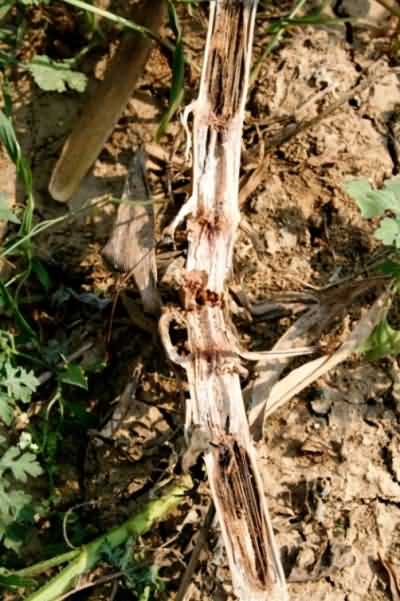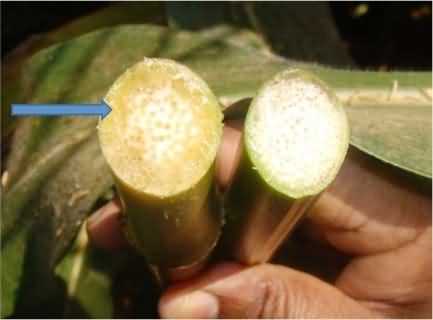मक्का की फसल में फूल आने के बाद की तना गलन या सटॉकरोट बीमारी और उसके प्रबंधन की विधियॉं।
Post flowering stalk rot (PFSR) of maize is an important disease in India. It is a ‘complex’ disease – as more than one pathogen is involved- caused by Fusarium verticillioides, Macrophomina phaseolina and Harpophora maydis.
Yield loss is directly affected by premature plant death or by reduced kernel filling and lodging, resulting up to 100 percent loss. The disease symptoms manifest after flowering and gets severe under moisture stress/ high soil temperature conditions.
Being soil borne, its transmission occurs through contaminated seeds, biological culture, infected crop residue and movement of agricultural equipmnts, therefore the use of IPM strategies for its management is crucial.
Maize is the third most important food crops after rice and wheat in India. It is cultivated throughout the year almost in all the states of country for various purposes including grain, fodder, green cobs, sweet corn, pop corn, baby corn etc. Ubiquitous incidence of diseases in the pre-harvest stage is major factor adversely affecting productivity.
Post flowering stalk rots of maize is a globally important destructive disease. In India, this disease appears in Rajasthan, Uttar Pradesh, Bihar, Andhra Pradesh, West Bengal, Punjab and Madhya Pradesh, where there is scarcity of irrigation coupled with high soil temperature.
Three kinds of soil borne stalk rot prevails namely charcoal rot, fusarium stalk rot and late wilt caused by Macrophomina phaseolina, Fusarium verticilloides and Harpophora maydis respectively (Table1). Initial symptoms of stalk rots i.e., premature wilting and ear drop are noticed when plant approaches maturity.
As the disease progresses stalks senesce occurs rapidly and turn brown to grey. Stalk rot pathogens decay the central pith loosely packed inside, which weakens the stalk and easily lodge, or bend when exposed to hail storm and windy conditions. They reduce both quantity and quality of the grain and may increase cost of cultivation.
It poses moderate to severe threat to corn production in India where it occurs endemically, with incidence as high as 70% and economic losses up to 51%.
Table 1: Characteristics of pathogens responsible for PFSR in maize
| Disease | Charcoal-rot | Fusarium stalk rot | Late Wilt |
| Causal Organism | Macrophomina phaseolina | Fusarium verticilloides | Harpophora maydis |
| Distribution | Jammu & Kashmir, West Bengal, Punjab, Haryana, Rajasthan, Delhi, Uttar Pradesh, Madhya Pradesh, Andhra Pradesh, Karnataka and Tamil Nadu | Most common in Rajasthan, Uttar Pradesh, Bihar Jammu and Kashmir, Punjab, Haryana, Delhi, West Bengal, and Andhra Pradesh | Andhra Pradesh, Uttar Pradesh and Rajasthan |
| Favorable conditions | Warm temperature (30-400C) and low soil moisture during grain filling stage | Most common in dry, warm regions and, more in sandy soil, sudden changes in weather condition at the time of flowering. | Disease develops rapidly at 20˚C- 32˚C, but the optimum temperature ranges from 21˚C - 27˚C |
| Symptoms | leaves turn to dull green color , lower stalk becomes yellow at flowering , grey-black sooty discolorations on the lower internodes, black specks are visible in the shredded vascular bundles when the stem is split open | Initially wilting of leaves turning dull grey-green in colour. Rotting extends from roots to the lower stalk become softens, prematurely dry and topples down. The inside of a rotted stalk has a whitish - pink to red discoloration when split open | Green stripes on leaves with leaf rolling, yellowish or reddish brown streaks on the basal internodes, rapid wilting of plants at 70 to 80 days stage. Affected plant dries up, get shrunken and hollow turn into purple to dark brown on lower 1-3 internodes with typical sweetish smell |
| Losses | Yield losses as high as 70% worldwide; in India reported 10 to 42% | Extensive losses are possible up to 100% under severe disease infestation | Economic losses up to 51% |
Photograph of infected plant
Black sooty infected stem (split open) Pinkish discoloration in infected stem Brown discoloration of vascular bundles
Predisposing factors, responsible for stalk rots
Favorable condition in early cropping season followed by stress after flowering, increases stalk rot incidence. Stresses include drought, high soil temperature, coupled with heavy applications of nitrogen, foliar disease, hail damage, prolonged cool, cloudy weather etc.
Abrupt changes in weather prior to pollination, favor the development of stalk rot fungi. The soil borne stalk rot pathogens remain in the roots, in an avirulent form giving plant a healthy appearance. But under stress condition at grain filling stage pathogen become aggressive and plant become symptomatic. Various predisposing factors responsible for stalk rots are:
1. Carbohydrate Stress
The carbohydrate levels in the stalk tissues get depleted during grain filling stage, as the ear leaf cannot fulfill the requirement and carbohydrates are mobilized from the root and stalk. Hence natural resistance of the stalk diminishes because the production of chemicals for defense of plant tissues is reduced and the stalk rotting organisms spread from the root system into the pith tissues of the stem.
Consequently, insufficient water moves to the leaves meeting the demands of transpiration leading to wilting of plants. Simultaneously stalk-rotting pathogens become virulent and release cell degrading enzymes like cellulase and pectinases that weaken the stalk tissues.
2. Unbalanced use of Fertilizer
Potassium (K) is an important nutrient as it is involved in stomatal functions as well as metabolic pathways. When plants are deficient in potassium, the photosynthesis rate is lower and may result in pith senescence. Hence, maintaining a sufficient supply of potassium to prevent lodging needs more attention in maize hybrids.
The response to phosphorus varies with the season, cultivar and the pathogen while higher level of phosphorus does not decrease stalk rot severity. Lower dose of Potassium coupled with higher dose of nitrogen favors stalk rot incidence. Also, limited access to nutrients is critical to photosynthesis, can cause carbohydrate stress that favors stalk rot.
3. Water stress
Abundant moisture before flowering promotes good ear development and high kernel numbers but if the post flowering environment is dry and water stressed, stalk rot is likely to occur. Incidence of charcoal stalk rot is increased if water stress conditions prevailed just before and after pollination.
The hot and dry condition, especially when crop is at silking stage predisposes the plants to infection by F. moniliforme.
4. Foliar diseases
Foliar diseases cause substantial loss of leaf area and predisposing the maize crop to stalk rot. The less leaf area reduces the rate of photosynthesis, responsible for insufficient carbohydrate production for developing ears. As a result more amount of carbohydrate translocate to the developing ear from the stalk and weakens it.
5. Insect and nematode damage
There is good evidence that insect and nematodes often increase the amount of root rot in the presence of pathogen. Occurrence of weed, insect and nematode in cropping field is predisposing factor for more stalk rot as they facilitate the easy access to stalk rot producing fungi through the roots and help in establishing these fungi in maize plant.
Management practices for post flowering stalk rot of maize
Stalk rots cannot be entirely controlled but damage can be reduced through the conscious use of an integrated management program. To effectively manage maize crop for the stalk rot, it is preferable to prevent or manage a disease outbreak when the disease is at initial levels. By adopting the following practices we can manage the losses due to stalk rots.
1. By selecting well-adapted, disease-resistant hybrids
Hybrids resistant to foliar diseases are less prone to this disease. Hybrids with stay green character, good plant stand ability and thick stalk with good strength can withstand even if attacked by insect or other pathogen in the interior of the stalk (Table 2).
Table2. List of Hybrids resistant to PFSR disease
| Hybrid | Area of adaptation | Maturity |
| Pratap QPMHybrid-1 | Rajasthan, Gujarat, Madhya Pradesh ,Chhatisgarh | Medium |
| Bisco 97Gold | Jammu & Kashmir, Himachal Pradesh, Uttarakhand and NE hills | Late |
| S6217 | All over India except Himalayan belt and NEH | Medium |
| Yuvraj Gold | All over India | Medium |
| PMH 1 | Punjab , Haryana, Delhi, UP, MP | Late |
| PMH 2 | Delhi, Haryana, Central and Western UP | Extra early |
| HM 11 | Across the country except Himalayan belt | Late |
| PMH 4 | Delhi, Punjab, Haryana, tarai UA and Western UP | Medium |
| PMH 5 | Rajasthan , Gujarat , MP and Chhattisgarh | Early |
| HQPM 4 | Across the country except Himalayan belt | Late |
| DHM 111 | Andhra Pradesh | Medium |
| DHM 117 | Andhra Pradesh | Medium |
Source: DMR Annual Report
2. Adoption of balanced soil fertility
As per the field experiments conducted, the higher dose of potash (80 kg/ha) can reduce up to 76% of PFSR incidence with 37.8 % increase in yield. Maintaining a sufficient supply of potassium to prevent lodging is necessary. However fertilizer should be applied based on the results of soil tests.
| Recommended dose of fertilizer | For managing PFSR incidence |
|
150-180 kg N, 70-80 kg P2O5, 70-80 kg K2 O and 25kg ZnSO4 per hectare |
Along with recommended dose, higher dose of potash (80 kg/ha) to be applied:· ½ dose at basal· ½ at knee high stage of crop |
Source: DMR Annual Report
3. Avoidance of biotic and abiotic stress through proper irrigation, soil management, and control of foliar disease
Timely irrigations to avoid water stress especially before and after flowering to keep the soil moist checks stalk rot. Also by controlling insect, nematode and foliar diseases helps in reducing stalk rot incidence.
Crop rotation with non grass crops like vegetable crops viz., cucumber, gourds, pumpkin, potato, tomato, cabbage, cauliflower and legumes like mustard, soybean, pea, pigeon pea, mung bean etc. in conjunction with a deep ploughing of corn residues is beneficial in reducing the inoculums load of PFSR producing fungi.
4. Adopt the recommended plant population
Increased plant population i.e., reduced plant to plant distance from 20 cm (recommended) to 10 -12 cm results in higher plant densities responsible for reducing the water, light, and minerals availability to each plant, is a main factor predisposing corn to stalk rot. This result in spindly stalks with reduced plant stands ability and reduced resistance to infection.
5. Practice regular field scouting
Scouting fields regularly on a weekly basis is the best way to determine disease/pest levels. An effective scouting procedure is to walk through cropping field in a zig-zag pattern and check the stalks below the lowest node to check for firmness. Another method is to push random plants about 5 inches from the vertical. If more than 10 to 15 percent of the plants lodge using this procedure, it would be beneficial to harvest the field early to prevent potential harvest losses.
6. Integrated Pest Management

Figure 1: Integrated management schedule for PFSR
Summary
Pre disposing factors responsible for increasing the incidence of post flowering stalk rot in maize are drought, high soil temperature, high plant populations, soil compaction, poor fertility, insect injury and foliar diseases.
Mitigating the losses incurred by PFSR can be achieved by applying management options:
1) use of hybrids with resistance to stalk rot pathogens,
2) adoption of soil fertility,
3) irrigation to avoid moisture stress, critically at flowering time,
4) adoption of integrated management practices.
Authors:
Meena Shekhar1, Nirupma Singh2 and Diwakar Bahukhandi 3
1 Principal Scientist, 2 Scientist, Indian Institute of Maize Research, Pusa Campus, IARI, New Delhi-12,
3 Senior Scientist, Division of Plant Pathology, IARI
1email:



